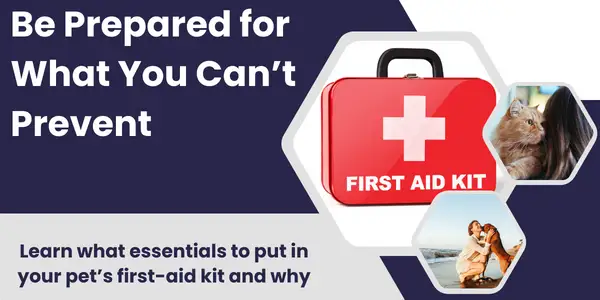
Heatstroke is a term that describes hyperthermia – a dangerously elevated body temperature.
In general, a temperature over 103°F is considered dangerous. This can happen when a pet is sick or has an infection.
However, anytime a cat or dog's body temperature climbs over 104°F in the absence of any other illness, it is usually related to excessive heat and considered heatstroke.
Symptoms of heat exhaustion usually happen before symptoms of heatstroke, and prompt treatment can sometimes prevent the progression to heatstroke.
This article will provide you with basic first-aid steps you can take when your dog or cat is suffering from either heat exhaustion or heat stroke and help you tell the difference between the two.
Skip to section:
The Difference Between Heat Exhaustion and Heatstroke
How can you tell the difference between heatstroke and heat exhaustion? Generally, heat exhaustion is a milder form of heatstroke. The body temperature is not above 104°F, and your pet can still walk, is panting and looking for water sources, as well as taking frequent breaks.
In heatstroke, the body temperature goes above 104°F. You will see warning signs like panting excessively with no breaks in between, collapse, dark red gums, a glazed look in their eyes, and your pet may seem unresponsive to you.
Both scenarios require immediate care on your part! If you're not sure if your pet is suffering from heat exhaustion or heatstroke, go to our other article that outlines all the signs and symptoms.
Getting your dog’s temperature is critical. A rectal thermometer has always been the ‘gold standard’ used to assess your pet’s body temperature accurately. You can use an old-fashioned glass thermometer (ideally mercury-free) or a digital thermometer that you might have on hand for human use – it can also be used as a rectal thermometer in a pet. The other option is the Mella non-invasive pet thermometer. It allows you to take your pet's temperature under their armpit. The values can be sent to your phone so that you don’t have to try and remember the number, and you can easily share them with your veterinarian.

How to Treat Heat Exhaustion in Dogs and Cats
- Immediately move your pet into a shady area or an air-conditioned environment.
- Offer small amounts of cool or room-temperature water every few minutes. Do not force them to drink.
- Take your pet’s temperature.
For a rectal thermometer, you can use the glass kind or use a digital thermometer rectally in your pet. Use OB lubricant, Vaseline®, or saliva if you have nothing else before inserting it into the rectum.
If using an armpit thermometer like Mella's, turn the thermometer on by clicking the button once, lift your pet's foreleg, and place the tip of the thermometer in the armpit. Click the button again to get a reading. It takes about 10 to 15 seconds to get a measurement. - If the temperature is below 104°F, then continue to monitor your pet closely, offering water and making sure they are resting in a cool spot. Take their body temperature every 60 seconds to make sure it continues to come down. If their temperature is not coming down over a five-minute period of time, then it’s time to seek veterinary care.
- If the temperature is above 104°F, then proceed to the cooling measures described in the treating heatstroke section below.
- Once your pet has stopped panting or is doing it very intermittently, you can continue to monitor for the next 24 hours.
Your pet may seem tired and not have much of an appetite for the next day or two. This is normal. However, they should be back to themselves, eating and drinking with no lack of energy within 48 hours. Seek veterinary care if, after the initial cooling period, your pet has not returned to their normal self. Or, if you see vomiting or diarrhea, especially with blood, go to the veterinary hospital immediately.
Questions? If you're concerned your pet may be suffering from heatstroke and would like to speak with a veterinarian, Click here
How to Treat Heatstroke in Dogs and Cats
- Move your pet into a cool and shaded area or an air-conditioned environment.
- Start keeping track of the time you started treatment and cooling measures – this will be important information for your veterinarian.
- Place a wet towel underneath your pet for them to lay on. Do not put ice or an ice pack directly on your pet's skin or under them.
- If they are conscious and alert, offer small amounts of water every few minutes. DO NOT try to force a pet that is not awake and alert to drink water. Do not use cold water. This may lower body temperature too quickly, and this is dangerous.
- Take your pet’s temperature.
For a rectal thermometer, you can use the glass kind or use a digital thermometer rectally in your pet. Use OB lubricant, Vaseline®, or saliva if you have nothing else before inserting it into the rectum.
If using an armpit thermometer like Mella's, turn the thermometer on by clicking the button once, lift your pet's foreleg, and place the tip of the thermometer in the armpit. Click the button again to get a reading. It takes about 10 to 15 seconds to get a measurement. - If the temperature is above 104°F, then start cooling your pet by spraying lukewarm – not cold – water over their body, focusing on the paws and behind the ears, as well as over their back and on their abdomen. You can also place wet towels over these areas if you do not have access to a hose, but you MUST continuously remove and replace them, as they trap and retain heat against your pet's body.
- If you have a fan, place it near your pet. This will help with evaporative cooling.
- Now is the time to start planning to get your pet to the veterinarian as soon as possible. If you started cooling measures, then mark down the time you started them.
- Take your pet's body temperature every 30 to 60 seconds – once it is below 103.5°F, stop cooling measures. Further cooling can drop the body temperature too low. Note at what time the temperature dropped and cooling measures were stopped.
- You should be on your way to the veterinarian at this point. It is ideal if you can pre-cool your car before placing your pet inside, as well as calling ahead so the hospital knows you are on your way.
When Not to Attempt Pet First Aid for Heat Illness
There are times when being able to administer first aid is not possible, or it will delay life-saving treatment for your pet. In these circumstances, you should get your pet to your veterinarian or the nearest emergency clinic immediately. Some conditions that may prevent you from being able to give first aid before seeking ER care are:
- No cool water or shade is available
- You do not have access to a thermometer
- Your pet is vomiting or having diarrhea, especially with blood
- You notice red or purple areas of bruising on your pet's skin or gums (these small, pinpoint bruises, called “petechiae," are often most visible inside the ears or on the underside of the belly)
- Your pet is collapsed, unresponsive, or having seizures
Important Do's and Don'ts for Cooling Down Your Pet
- Do NOT pour water into the mouth of a collapsed or unconscious pet, and don’t force any pet to drink water.
- Do NOT use ice water or an ice bath to cool an overheated pet. This can lead to constriction of the blood vessels under the pet’s skin, which will actually prevent evaporative cooling.
- Do NOT cool your pet too fast or too long – overcooling can be as disastrous as overheating.
- Do monitor rectal temperature every 30–60 seconds.
- Do stop cooling once their temperature reaches 103.5°F.
- All pets suffering from heatstroke (and many suffering from heat exhaustion) still need to be evaluated by a veterinarian once your initial cooling measures have been completed.
Will My Dog or Cat Survive Heatstroke?
Once you get your pet to the hospital, they will immediately assess body temperature and do blood work to look at how your pet's organ function is affected.
They will also start fluids and continue cooling measures if needed. The prognosis for survival depends on how high the temperature was, how long it was elevated, and what your pet’s physical condition was before the heat illness. Older and overweight animals have a lower chance of survival, as well as young animals or ones with an underlying illness.
Most healthy pets will recover quickly if they are treated immediately. If treatment is delayed, then permanent organ damage and even death can occur. The key to preventing this tragedy is to be well prepared and know the symptoms to look for and intervene quickly.




